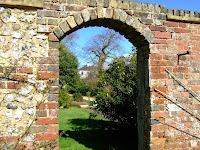
Sunday started with our second visit to
Witley Court, a romantic ruin of a grand house built in the 19th century, by the then richest man in England, whose wealth came from coal. In a strange irony, this mansion, built from the profits of fuelling fires, was ruined by a fire that destroyed part of the house in 1937. Uneconomical to

repair, the rest was stripped and the result today is a picturesque ruin. In it's day, this mansion was a real showpiece.
The interior of the attached chapel was purchased from a bankrupt aristocrat and is an amazingly unexpected celebration of Baroque architecture. However, these places are not really seen at their best on a grey overcast

morning and it was not long before the low temperature hinted that it was time to press on.
Our lunch stop was the picturesque village of Henley-in-Arden: the long main street has, apparently, examples of nearly every period of English architecture and is well worth a visit.

Then it was on to the ruins of
Kenilworth Castle. The original keep was built in the time of the Norman Conquest. (They certainly were an industrious bunch, the conquering Normans: they scattered castles all over the land.) A variety of owners added to it and ultimately Elizabeth I gave the Castle to Robert Dudley, her childhood

sweetheart and Court favourite. She visited the property 4 times, although she stayed with Dudley a total of 23 times, at his various houses. The only currently inhabitable building is the original gatehouse, built as an impressive gateway by Dudley for one of her visits.

The final stop of the day was the attractive village of Berkswell, named after a well (actually a spring) in the village. The church is picturesque outside and inside and has a rare vaulted crypt, open for visitors. The half-timbered porch was the original priest’s lodging. It is the second Church we have seen with mice carved into the woodwork: we only found one of the 17 in the time we had available.


 Summer seemed to arrive with the 1st of April. After a quick look at Kettering we headed to Thrapston to do a walk around the canal and lake system there. We finished the walk at the Nine Arches Bridge over the River Nene. A seven arch bridge was built in medieval times and replaced in 1795 with a 24 arch bridge. This was reduced to the current structure in the 1840s after the arrival of the railways.
Summer seemed to arrive with the 1st of April. After a quick look at Kettering we headed to Thrapston to do a walk around the canal and lake system there. We finished the walk at the Nine Arches Bridge over the River Nene. A seven arch bridge was built in medieval times and replaced in 1795 with a 24 arch bridge. This was reduced to the current structure in the 1840s after the arrival of the railways. Higham Ferrers was the next stop: the main feature of this attractive town is a medieval chapel and gatehouse, which is all that remain of Chichele College, a lay institution set up, around 1425, to pray for the souls of the founder and the King.
Higham Ferrers was the next stop: the main feature of this attractive town is a medieval chapel and gatehouse, which is all that remain of Chichele College, a lay institution set up, around 1425, to pray for the souls of the founder and the King.
 We had picked up a walking trail around the town of Kimbolton so we headed over to Kimbolton to check it out. The town is well worth a visit: highlights were the Castle, now a school, but- formally the residence off the Duke of Manchester; the other highlight was the Tiffany window in the local church, which the Duchess commissioned in 1900 from Tiffany of America, to commemorate the early deaths of her two daughters.
We had picked up a walking trail around the town of Kimbolton so we headed over to Kimbolton to check it out. The town is well worth a visit: highlights were the Castle, now a school, but- formally the residence off the Duke of Manchester; the other highlight was the Tiffany window in the local church, which the Duchess commissioned in 1900 from Tiffany of America, to commemorate the early deaths of her two daughters.




































